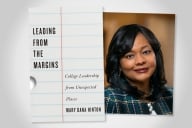You have /5 articles left.
Sign up for a free account or log in.
The Reconstruction era in the United States quickly turned into a period of segregation in many aspects of society, including higher education. Predominantly white institutions in the South kept black students out. While some historically black colleges were created, social norms and the law largely prevented them from attracting white students. But during this same period, an idealistic organization called the American Missionary Association -- which had been an abolitionist group -- worked to create and support colleges in the South that educated black and white students, men and women, together. The efforts faced strong local opposition, and not all the institutions were able to maintain the spirit of equity that the association promoted.
A new book, Reparation and Reconciliation: The Rise and Fall of Integrated Higher Education (University of North Carolina Press), tells the story of this push in higher education. The author is Christi M. Smith, a visiting assistant professor of sociology at Oberlin College. She responded via email to questions about her book.
Q: The idea of educating black and white students together (and men and women together) was radical when the AMA pushed this approach. What motivated the association?
A: The motivation for anti-caste coeducation was a belief that racism threatened political stability -- and that whites needed to be educated out of their sense of superiority. Twenty years earlier, before the U.S. Civil War, revolutions across Europe and parts of South America brought an end to feudalism, and anti-casteists (including those who were members of the AMA) interpreted violence as an inevitable outcome to extreme inequality. They interpreted slavery as a more brutal variation of feudalism. And they imagined that the only way to create lasting peace was by destroying status-based hierarchy, including hierarchies based on race. The AMA was an international Protestant organization with projects in nearly every U.S. state, so it was a very large operation. Leaders in the organization were abolitionists and by the 1880s also spoke out against the brutal state oppression of Native peoples, against discrimination toward Chinese immigrants, and worked to increase opportunities across the South for poor whites and African-Americans. It was a very dynamic organization and underwent tremendous change in the 19th century.
Q: The American Missionary Association fought slavery in the period before emancipation. How did its focus shift to education?
A: The AMA believed that education could help repair the damage done to the American democracy by slavery. They believed that brokering peace required dismantling the American caste system, and thought that founding a network of colleges was an intermediary step toward their goal. The AMA described race as a caste system where our everyday actions, customs and manners all contribute to the perpetuation of racial inequality. Most often, higher education is promoted to further individual social mobility, but the AMA stressed its political importance. The AMA hoped that the controlled environment of a college campus, sheltered from outside influences and with the opportunity for making close friendships across the color line, would create interracial solidarity. And major Northern newspapers responded to these claims that college campuses could offer a place for reconciliation. By 1884, one newspaper declared that at Berea College “equality is achieved …. What has been done there can be done everywhere in the South, and must be.”
One of the ideas I develop in the book is that higher education became so politically charged because it was very quickly entwined with debates over citizenship. Traditionally, citizenship scholars focus on citizenship rights stemming from place of birth (jus soli) or blood (jus sanguinis), and I find these concepts do not apply to struggles over American citizenship. I introduce the term “jus laurea” to describe the logic that citizenship rights should be based on achievement. This is first manifest in claims that African-American men deserve citizenship based on their loyalty and service in the Union Army. Anti-caste colleges were used by journalists and politicians as evidence of African-Americans’ accomplishment, and even though this is largely “good press,” it has a deleterious effect. The AMA’s emphasis on coeducation is drowned out and, by the 1890s, colleges are describing their own importance in producing valuable citizens. One Howard University president compared its black college graduates to gold coins, arguing that a college education would make their value incontrovertible to the nation. So the stakes were set incredibly high, but college campuses became a place to adjudicate who deserved citizenship -- but access to the colleges that offered the highest returns in status were incredibly limited, and indeed as more colleges for African-Americans opened, more Northern and predominately white colleges expressed feeling justified in not admitting African-American students.
Q: What challenges did the association face in promoting this vision?
A: Despite having important allies in Congress and other federal offices, the AMA fought against state and federal funding because they felt that overcoming racism was fundamentally a religious project and not a matter for state intervention. Instead, the AMA took a gamble that religious donors and philanthropists would continue to support their efforts. That worked against them. There was no regulation or oversight of higher education. The postwar years saw a dramatic increase in the number of colleges, with more than 130 new colleges for African-Americans founded after the war and before 1900, and dramatic increases in other college foundings, too. So the competition for funding and students ramped up very quickly, and colleges were struggling to define their market niche.
Q: Some of the colleges founded by the AMA are now known as historically black colleges, and others became predominantly white. How did this evolution take place?
A: I took an intersectional approach to investigate how relations between and across groups matter for the stratification of educational opportunities. Thinking about these colleges through the lens of a social field is critical to understand the dynamic and relational nature of the processes that thwarted integration. For instance, most accounts describe the rise of women’s education and HBCUs as largely without impact on colleges and universities for white men and often present the rise of these forms as “pioneering” in opening access to previously excluded groups. By contrast, I show how successful efforts at integration -- both in terms of gender and race -- were interrupted and that the rise of a competitive field of higher education legitimated social exclusion -- both for African-Americans and white women.
Q: Can you point to AMA roots still evident in the colleges it founded?
A: Given that my research was historical, I think this is more of an empirical question and opens up terrific opportunities for campuses to tackle these issues. There have been some wonderful initiatives to look at the contemporary manifestations of the complicated histories of colleges and universities. To give a couple of quick examples, then President Ruth Simmons appointed a Steering Committee on Slavery and Justice at Brown, and Leslie Harris (history, Northwestern University) co-convened the two-day conference “Slavery and the University: Histories and Legacies” at Emory. Steve Volk (director, Center for Teaching, Innovation and Excellence at Oberlin) and I are putting together a workshop at Oberlin where students, faculty and staff will read selections from my book and work through some of themes of the book in contemporary perspective. I’m hopeful that more campuses will create initiatives along these lines.
Q: Today we live in a divisive time, and many students lack the chance to obtain a higher education. Are there lessons from the AMA in what policies might be pursued today?
A: I do think there are a number of concerning parallels and many lessons for our current moment. By the end of the 19th century, a rather chaotic array of colleges and universities had developed into an organizational field with a shared logic: to compete against an ever-increasing number of colleges, types of education should be matched to particular groupings of people as a means to attract donors. Characterized in broad strokes, this resulted in a segmented system of higher education by race, class and gender. And this kind of variation and stratification in higher education is increasing, and higher education marketing firms promote market segmentation to effectively recruit and retain paying students. While we’re once again seeing a dramatic upsurge in college enrollment -- and graduation -- students of color and low-income students are put on pathways to nonselective colleges. Roughly 70 percent of black students entered open-enrollment or two-year college programs, while 82 percent of new white students entered the 448 most selective colleges in the United States (see work by Anthony Carnevale at Georgetown). So I think one of our challenges is to not just increase access but to insure that students are entering colleges where they have access to tenured faculty and challenging courses of study.
Understanding the first effort to integrate higher education is incredibly important right now. College students are calling out the ways in which slavery and colonialism have been woven into campus life, and addressing these legacies is important work. Court cases (Fisher v. University of Texas, Grutter, Gratz and others) have had an impact on what universities are able to do in terms of integration. And we have also seen states back away from funding higher education, and leaving colleges vulnerable to market pressures that can undermine integration. We can’t leave something so important for robust democracy up to the market or to philanthropists. What we learn from the AMA is that universities are ill suited to the work of remedying deeply entrenched racism and social inequality, but I believe they were right to attend to the political importance of higher education.








